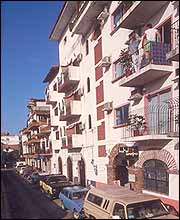It’s 11 p.m. on Playa Candelero beach out on Espiritu Santo, the uninhabited island five miles off La Paz. A half-dozen tents stake out the shoreline beside an impromptu harbor: a fleet of beached sea kayaks and a skiff loaded down with freshly filled air tanks, ready for the morning dive. Campfire embers are falling into ash, and the night is quiet save the neighborly barks of the sea lions camped out on Isla la Partida, a mile to the north.
Welcome to Baja California’s East Cape, the rustic yin to Cabo’s golf course┬í and cigar bar┬ísaturated yang. Running south from La Paz to the mouth of the Gulf of California, this oft-ignored eastern tip of Baja hasn’t changed much since the days of John Steinbeck. Despite long-discussed plans for a paved route that perhaps five years from now will wind through the Sierra de la Laguna and link up with the Los Cabos highway, most roads here are still bad, ribbed with washboard and sandy sinkholes that can swallow a tire whole. Boils of tuna and plankton still draw all manner of giant sea creatures: orcas, humpbacks, and gray whales, elusive hammerheads and whale sharks. Out on Cerralvo Channel, winter winds still blow steady and hard, exhausting the most dogged of boardsailors. And come spring the gulf still turns to glass, with 100-foot visibility over a rare coral reef cruised by dozens of neon-hued fish.
As you might expect, the dog days of summer—August 15 through September 15—can be deadly: up to 110 degrees during the day, 95 at night. But the big surprise is that the rest of the year, even through July, is quite nice, especially if your sports are water-centric. Diving and sea kayaking are best from March through December, though possible year-round. Windsurfing and mountain biking are ideal during winter and early spring. And all year, water temperatures are as much as ten degrees warmer than those of the Pacific, ranging from the seventies to the eighties.
Whatever the season, the best way to launch a tour of the East Cape is to fly into La Paz, at its northern boundary.
La Paz
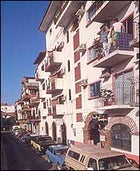
The capital of Baja California Sur, La Paz straddles a sheltered bay dominated by the dark mass of Espiritu Santo Island. The lure here is diving, specifically among a host of the world’s largest underwater inhabitants. But whether or not you plan to go deep, it makes good sense to spend a day or two exploring this slow, laid-back city of 180,000, picking up supplies for your travels to the south, and even pedaling the coastline on a rented mountain bike.
Instead of spreading out along the water, La Paz itself extends miles inland on progressively funkier dirt roads bordered by neatly painted stucco and cement-block homes. It has some charming hotels, a handful of discos, and adequate restaurants, including the perfectly passable Sushi Express and Tequila’s Bar & Grill, a great open-air cantina with pool tables and more than 200 varieties of the namesake hooch. While tourism drives the economy these days, time-share hawkers are blissfully absent. The locals, known as Pace┬▒os, display a generous hospitality rarely encountered in resorts, a trait generally attributed to environmental difficulties–ferocious heat, scarce fresh water, and occasional hurricane-force winds–which have historically demanded that both neighbors and strangers be assisted.
Conditions offshore aren’t nearly so tough, as evidenced by the crowds of pelagic fish and mammals that swing by La Paz Bay every year to snack on clouds of plankton: vast schools of yellowfin and yellowtail, manta rays with 20-foot wingspans, and just about every whale species that frequents the eastern Pacific, from minkes to sperms to blues. “In ten years of professional diving, the only time I’ve been stunned was when I turned around and saw a 30-foot humpback coming toward me,” says James Curtis, divemaster at La Paz’s Cortez Club. “I didn’t breathe for about half a minute. It came within ten feet of me, and the surge of it passing lifted me backward. It just looked at me and went on.”
Even fans like Curtis admit that it requires a bit of patience to motor out to many of the 45 local dive sites, which are scattered from 45 minutes to two hours away. Farthest afield is the internationally known Marisla Seamount, where hammerhead sharks school 100 feet down. The 28-mile boat ride north takes half a day, making live-aboard charters a more comfortable option.
La Ventana and Los Barriles
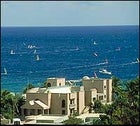
Like the snows of Alaska, the winds of the East Cape are a defining local aspect, shaping the land as much as the people, even taking on distinct personalities of their own. The sultriness of late summer and early fall, for example, is often tempered by a coromuel, a moist southerly named after Cromwell, the British pirate who captured Spanish treasure galleons by strategically using his knowledge of local gusts. Sometime after St. Francis Day (October 4) comes the last hurricane of the season: el cordonazo de San Francisco, or Saint Francis’s whiplash. From then on, North American boardsailors compulsively monitor Internet weather sites waiting for a high-pressure system to build over the southwestern United States–at which point they pack their gear and head for either La Ventana or Los Barriles.
At the end of a dusty road 40 minutes south of La Paz, the sleepy fishing village of La Ventana huddles on a 15-mile beach facing Cerralvo Channel. La Ventana means “the window,” an apt name given that, from December through March, this particular casement is wide-open to the 45-knot northerlies that barrel down the gulf like subway trains screaming through a tunnel.
Thanks to the forgiving direction of the prevailing winds, though, beach launches here are easy even for novice boardsailors, and the long, gradual arc of the bay creates a natural safety net for anyone who gets into trouble. Inevitably you’ll wind up on the sand, where a four-wheeler from one of the local rental shops will fetch you. Advanced sailors will find that the dark water farther out has little chop, thick rolling swells, and warm temperatures. Closer in, on the reef near town, you’ll find rollers that make for good play when the wind is just too strong out in the channel.
An underpublicized stop on the windsurfing circuit, La Ventana still offers no real hotels or nightlife, only one restaurant, and a handful of small places where you can rent gear and maybe a trailer to sleep in. But you can always camp on the beach, which is reliably hassle-free.
Things are much more civilized down at Los Barriles, a more established windsurfing spot and fishing center about an hour south. (Its similarly apt name, “the barrels,” refers to its past as a smugglers’ haven, when drums of tequila were illegally floated ashore.) Here you’ll find a wide range of hotel rooms, restaurants serving wood-fired pizzas, and grocery stores stocked with California wines and sunblock, earning the town’s other winking appellation: the southernmost suburb of San Diego. From mid-November to mid-March it’s also the Baja home of Vela, the reputable windsurfing academy that maintains seasonal outposts in windy locales from Aruba to Maui. Since manufacturers use the school to test new designs, most of its equipment is late-model, and you’ll appreciate its full quiver of sails once you experience the wide variety of local winds. (One tip: If you’re not staying at Playa del Sol or Palmas de Cortez but plan to rent from Vela, it’s best to reserve equipment at least a day before, since guests at these two Vela-affiliated hotels otherwise get first dibs.) Sail-swapping is a little more relaxed up in La Ventana, but in either place you should bring your own wetsuit and harness. If you’re choosing between the two spots, think of it like this: Los Barriles is the reassuringly structured university; La Ventana is the playground at recess.
Cabo Pulmo
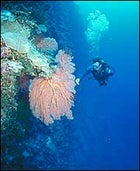
At the very tip of the East Cape, a few miles shy of Los Frailes, where cartographers have decided the Pacific and the Gulf of California meet, you’ll find the tiny hamlet of Cabo Pulmo—population around 100, depending on the season. There’s one general store, one cantina, no paved roads, no church, no school. (There is, thankfully, the ten-year-old Cabo Pulmo Beach Resort, with 22 clean, spacious cabanas.) The residents here dig wells or truck water in, get their power from solar panels or generators, and rely on a rough dirt track for contact with the outside world. The pioneer lifestyle, however, seems a small price to pay for living next to a Baja Sur natural wonder: a living coral reef, one of only three in the eastern Pacific. To protect the area, the Mexican government designated it a national marine park in 1995 and banned all offshore fishing.
Starting about a half-mile from the beach, eight fingers of reef angle into the sea. Divers here can see as many as 200 species of tropical fish, as well as sea lions, bat rays, huge oarfish, and columnar schools of Mexican hogfish. According to Pepe Murrieta, director of the marine park and owner of Pepe’s Dive Center (011-52-114-10001), whale sharks have come as close as 100 feet from shore, and last season a school of hammerheads nested beside one of the reefs. The sites are never very crowded; even at the peak season around Easter you’ll see no more than a dozen divers at once. And since most of the sites are shallow, snorkeling is also quite good here.
You can explore Cabo Pulmo’s landscape via several other means as well. Experienced kayakers will want to paddle the series of small scalloped bays that terminates at Los Frailes Point and its sea lion colony. (Beware the strong currents that start a quarter-mile offshore during windy winter months; remember that you’re quite near the open ocean.) If you’ve brought your own gear you can also windsurf; Cabo Pulmo was the big secret spot in the late eighties, before La Ventana was “discovered.” Every fall during hurricane season, surfers hit town and head for the break at Boca de Tulas, about 20 minutes south of Los Frailes. Back on land, hikers and mountain bikers can wander among the willows, wild figs, and palms shading the foothills that rise between the arroyos curving down to the gulf. Stop by Pepe’s, the first place you see as you enter town, to pick up maps. Many of the local trails start just behind the shop, which also offers a two-hour guided hike to an ancient Pirecue petroglyph site. Along the faint trails, test your recognition of herbs long harvested by the locals: oregano, sage, mistletoe, and damiana, the last used in lieu of triple sec to make “Baja margaritas.”
In many ways, Cabo Pulmo is the East Cape in miniature: a little-changed land of rare beauty less than 90 minutes from the condo sprawl of Los Cabos. Sitting on the sand at Punta Sirena, a few miles down the beach, you can look out to where the gulf meets the Pacific, an invisible line of demarcation. Back in the village, everybody talks of the government-advocated paved road that will someday link the two worlds—and just about nobody is eager for the new connection. For now, at least, this is old Baja
Access and Resources: How to Navigate the Baja Less Traveled
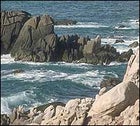
Getting there
Avoid the glitz of los Cabos by flying directly to La Paz, usually from Los Angeles. Round-trip flights on Air California (800-237-6225) start at $190. At the airport, Hertz (800-645-3001) rents compacts from $250 per week. Beyond La Paz, credit cards are virtually worthless, so carry sufficient cash.
Getting Situated in…
La Paz
If you want to stay in the heart of the city, try the beachfront Los Arcos (doubles, $75; 949-450-9000). Five minutes north is La Concha Beach Resort (doubles, $107; 011-52-112-16161), home of the water-sports-oriented Cortez Club. Hopeless scuba obsessives should head for Pichilingue Point and the Cantamar Hotel (doubles, $70; 011-52-112-21826), 25 minutes closer to the dive sites. Two-tank outings start at $80 anywhere in La Paz, but package deals can lower your combined hotel-dive costs to about $100 a day. (For details, call La Concha or Cantamar.) The Cortez Club also arranges custom kayaking tours of Espiritu Santo and beyond; a three-day trip costs $300.
La Ventana/Los Barriles
Boardsailors will probably want to rent sails and boards ($50-$60 per day) in order to easily swap out as conditions change. Ventana Windsurf (800-782-6037) rents a 450-square-foot yurt or a one-bedroom bungalow for $120 or $160 per night, respectively.
Among the more plush lodgings in Los Barriles, the Palmas de Cortez (doubles, $110-$140; 800-368-4334) offers great bay views and access to big-game fishing charters, which leave daily from the nearby dock and cost $66 or more per person, plus $10 to rent tackle.
Cabo Pulmo:
Cabo Pulmo Beach Resort (888-997-8566) has one-room bungalows and spacious casitas for $85 to $120 per night, and can also help arrange outings: A half-day of panga fishing runs $150; kayaks rent for $30 to $50. Right next door, Nancy’s Restaurant rents palapa-roofed casitas ($65-$85 per night; 011-52-114-10001). Whether or not you stay there, don’t leave town without sampling Nancy’s fare. The fresh snapper, organic veggies, and homemade bread recently earned a rave review in, of all places, the New York Times.


